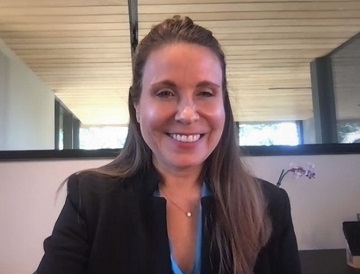Recap: Strategies to Overcome Transportation Barriers for Rent Burdened Residents
Susan Shaheen, PhD, of the University of California, Berkeley, Completes U.S. DOT Volpe Center’s 2021 Thought Leadership Series

On September 23, the U.S. Department of Transportation (U.S. DOT) Volpe National Transportation Systems Center (Volpe Center) welcomed Susan Shaheen, PhD, as the final speaker in the 2021 thought leadership speaker series, Innovation for a Sustainable, Equitable Transportation System.
Shaheen is the co-director of the Transportation Sustainability Research Center of the Institute of Transportation Studies at the University of California, Berkeley, and the director of the Institute’s Resilient and Innovative Mobility Initiative. She is a pioneer and thought leader in innovative mobility strategies and has authored 77 journal articles, more than 125 reports and proceedings articles, and 20 book chapters, and she has co-edited two books.
Shaheen is chair of the Transportation Research Board (TRB) Executive Committee. She received the 2017 Roy W. Crum Award from TRB for her distinguished achievements in transportation research. In May 2016, Shaheen was named one of the top 10 academic thought leaders in transportation by the Eno Transportation Foundation.
U.S. DOT Chief Science Officer and Deputy Director for Research and Technology Dr. Robert C. Hampshire opened the session with U.S. DOT Volpe Center Director Anne D. Aylward; each discussed the major themes in the 2021 series and the fresh ideas offered by each speaker. Aylward moderated a dialogue after Shaheen’s discussion of her research.
This post provides a recap of Shaheen’s talk. You can also watch video from the event.
The Co-Benefits of Shared Mobility
The East Bay community in Oakland, California, features a robust network of transportation options: heavy rail Bay Area Rapid Transit (BART) trains, bus, paratransit, and shared mobility options including Lyft, Uber, Zipcar, bikeshare, scooter sharing, and moped sharing.
However, the neighborhood is also considered a “community of concern” by the Metropolitan Transportation Commission, the region’s metropolitan planning organization (MPO). The designation is based on the anticipated social equity impacts of transportation planning projects. Many residents of the area are considered “low-income,” and many others are considered “rent-burdened.” The area also periodically experiences degraded air quality associated with vehicle emissions and traffic congestion.
Shared mobility is a transportation option that can meet environmental, sustainability, and equity goals by offering lower-cost and lower-emissions options to travelers. According to Shaheen, more research is needed into the unique transportation needs of low-income and rent-burdened populations to discover barriers to adoption of shared mobility services and potential policy options.
Travel Behavior of Rent-Burdened Individuals
Shaheen’s team developed a mixed-methods research plan that included a combination of focus groups, surveys, GIS analysis, and agent-based simulation modeling. One novel approach in this research was using “rent-burdened” as a screener metric instead of the traditional Federal Poverty Level metric. Rent-burdened individuals are those spending more than 30 percent of their income on housing. An extremely competitive housing market in Oakland and in the San Francisco Bay Area “captures a larger group of people than other definitions of ‘low income,’” according to Shaheen.
The study found that there was a high level of awareness of shared mobility services, but that in some cases, travelers felt they needed more hands-on education and training. The presence of options like scooters on sidewalks was effective at encouraging people to try them out for the first time, but a spatial analysis revealed that some areas had a dearth of shared vehicles (cars, scooters, or bicycles). Key barriers to more widespread adoption of on-demand shared mobility services included lack of familiarity, high or unexpected costs, lack of vehicles, and the need to use an assortment of unique and different smart-phone apps to access services provided by different private vendors.
Research-Based Policy Solutions to Incentivize Mode Shifts
Shaheen was keenly interested in using agent-based simulations to understand the effectiveness of different public policy strategies. By leveraging the Behavior, Energy, Autonomy, and Mobility (BEAM) model developed by Lawrence Berkeley National Laboratory, Shaheen’s team modeled incentives like fare/ride subsidies for different income groups and types of rides. The simulations revealed a likely network effect when subsidizing all pooled shared mobility riders regardless of income level or rent burden: public transit subsidies resulted in the greatest reduction of vehicle miles traveled (VMT).
From a policy perspective, adopting a “MaaS” or “mobility as a service” model can spark new and different approaches to achieve equity and sustainability goals. Discounted or fare-free transit, integrated mobility digital wallets, and a focus on an expanded group of users—the rent-burdened—can have significant impacts on regional transportation systems.
View video from Dr. Shaheen’s September 23, 2021, talk. To learn more about the U.S. DOT Volpe Center’s 2021 thought leadership program, please contact U.S. DOT Volpe Center Director of Strategic Initiatives for Research and Innovation Ellen E. Bell.
Video Highlights
The views of the speaker do not represent the views of U.S. DOT.
Celebrating more than 50 years of federal service to the nation, the U.S. DOT Volpe Center’s mission is to improve the nation's transportation system by anticipating emerging issues and advancing technical, operational, and institutional innovations for the public good.
